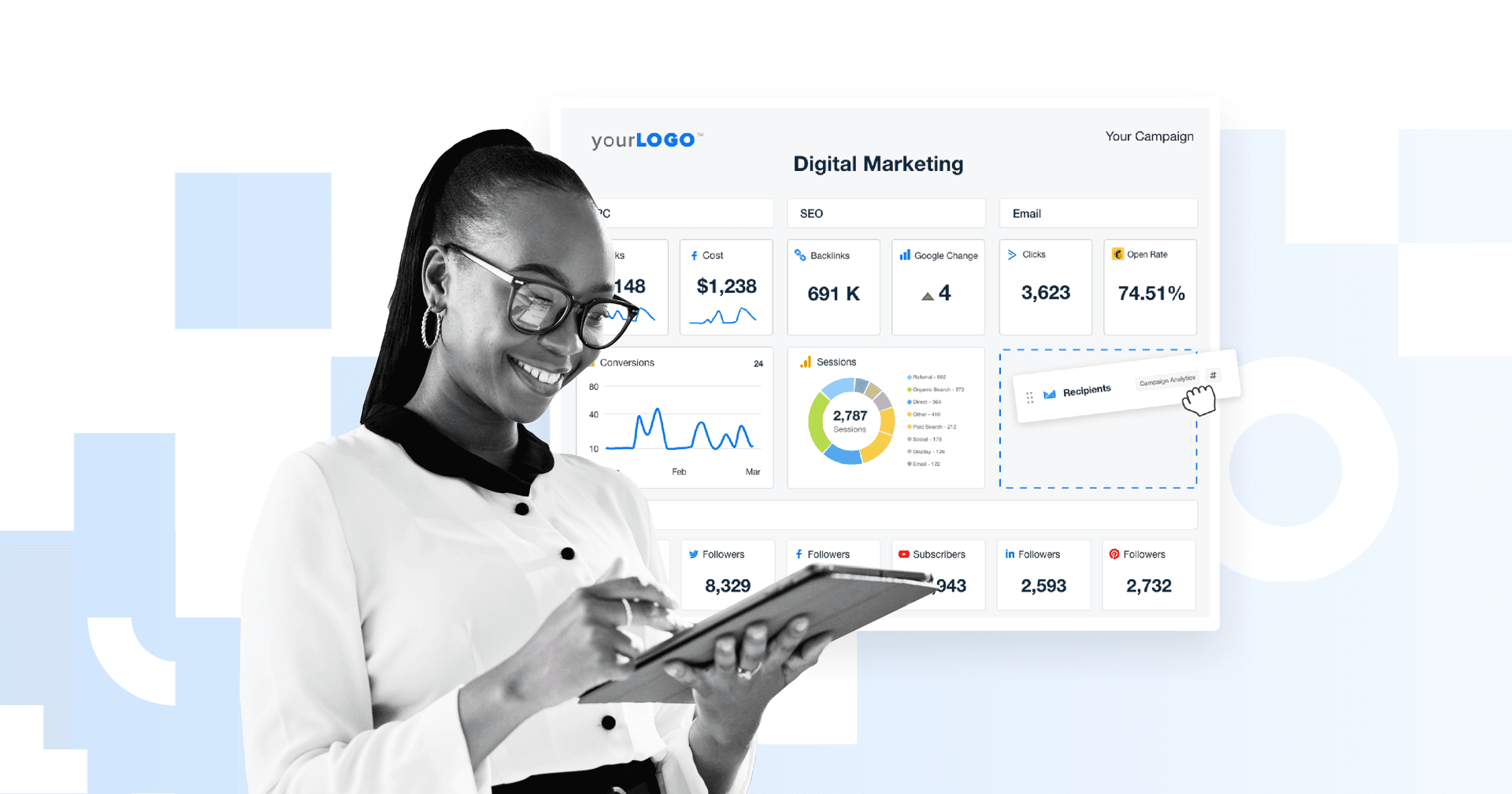Table of Contents
QUICK SUMMARY:
BigCommerce Analytics, integral to eCommerce success, offers comprehensive data insights for online businesses. This platform excels in simplifying website creation and management, while emphasizing data-driven decisions. In-depth reports on sales trends and customer behaviors are key features, aiding in strategizing and growing online presence. Dive into BigCommerce's robust analytics tools, highlighting their role in enhancing eCommerce performance.
Enter the world of BigCommerce analytics, a place teeming with actionable insights and pivotal data. Here, eCommerce marketers unearth the treasure trove of information needed to propel their clients toward exponential eCommerce growth. No magic, no smoke and mirrors, just a firm grasp of data and the skill to interpret it.
The critical tool in their arsenal? BigCommerce analytics reports. With these, marketers navigate the complex terrain of eCommerce data. It's a journey of discovery, helping clients sidestep pitfalls and seize opportunities within their business landscape.
Our goal? To simplify the process of creating BigCommerce client reports that matter, illustrating your agency's value, and driving decision-making.
There's a wealth of data to uncover, insights to glean, and strategies to formulate. Let's begin.
What is BigCommerce?
For those who have lived in a Shopify or WooCommerce bubble, BigCommerce is another leading eCommerce platform designed to simplify the process of running an online business. It's a one-stop solution that allows businesses to create, manage, and grow their online presence, all while offering robust eCommerce analytics.
Here's a snapshot of what BigCommerce offers:
Create and Manage an Online Store: At its core, BigCommerce is about providing a simplified way to create a website tailored to a brand's look and feel, add products effortlessly, and manage inventory, orders, and customer relationships all from one dashboard.
eCommerce Analytics Reports: One of BigCommerce's standout features is its emphasis on data-driven decision-making. The platform offers in-depth eCommerce analytics reports that provide insights into sales trends and customer behavior.
Integration with Other Tools: BigCommerce is designed to play well with others, including the AgencyAnalytics client reporting platform. It offers integrations with a host of marketing, shipping, and accounting tools. This seamless integration enhances efficiency, allowing online businesses to focus on what they do best: selling products.
BigCommerce is more than just a tool for creating an online storefront. It's a comprehensive solution underpinned by powerful eCommerce analytics to guide strategic decisions.
The Importance of Data in eCommerce Marketing
The eCommerce age has gifted us the ability to track, analyze, and leverage data like never before. The vast digital footprint left behind by online shoppers paints a comprehensive picture of behaviors, preferences, and trends, providing marketers with the insight needed to drive growth and profitability.

Quickly and easily pull all of your client’s eCommerce analytics into a customizable BigCommerce dashboard and send an actionable client report in minutes. Try AgencyAnalytics free for 14 days!
The secret to success in eCommerce marketing often boils down to the 4 R's–the Right message, to the Right person, at the Right time, in the Right place. Data makes mastering these 4 R's possible by shedding light on customers' identities, interests, and interactions with the digital world.
Let's explore why data is a vital cog in the eCommerce marketing machine.
Understanding and Segmenting Customers
First and foremost, data allows for a deep understanding of customers. It reveals their buying habits, preferences, demographics, and pain points. This wealth of information enables marketers to segment their audience into distinct groups and tailor marketing efforts accordingly, enhancing efficiency and engagement.
Personalization and Customer Experience
Data plays a crucial role in an era where personalization is vital to winning customer loyalty. It helps shape personalized marketing messages, recommend products, and customize the shopping experience. eCommerce businesses foster satisfaction and drive repeat business by using data to deliver what customers want when they want it.
Performance Tracking and Optimization
Data doesn't just illuminate the path forward; it also shines a light on the past. It allows marketers to track the performance of their marketing strategies, campaigns, and even individual advertising tactics.
By understanding what's working and what isn't, you have the data you need to optimize your efforts, tweak strategies, and continually improve.
Forecasting and Strategic Planning
Finally, data is the fuel that powers forecasting and strategic planning. Through data analysis, marketers are better equipped to spot trends, anticipate changes in customer behavior, and predict future sales. These insights help in planning marketing strategies, managing inventory, and even guiding business growth.
In essence, data is the lifeblood of eCommerce marketing. It's not just about numbers and figures; it's the behind-the-scenes language customers use to communicate their needs and wants. Understanding this language, interpreting it correctly, and responding effectively sets successful eCommerce marketers apart.
The Fundamentals of BigCommerce Analytics
BigCommerce analytics is a comprehensive tool that helps eCommerce marketers gather, analyze, and use data effectively. As a built-in feature of the BigCommerce platform, it provides real-time insights into an online store's performance, from traffic trends to sales numbers to customer behavior.
How BigCommerce Analytics Contribute to eCommerce Success
When used correctly, BigCommerce analytics become a game-changer for eCommerce success.
For example, knowing which products are bestsellers can help guide inventory management, while understanding peak traffic times can aid in planning targeted promotions. Also, it’s much easier to optimize digital marketing efforts across various channels when you understand where website traffic is coming from. BigCommerce analytics provide these insights and much more.

Furthermore, BigCommerce analytics help track and measure Key Performance Indicators (KPIs). These include metrics like conversion rates, average order value, and customer lifetime value, all of which offer an understanding of an online store's profitability and performance.
3 Types of Data to Track for BigCommerce Stores
To make the most of BigCommerce analytics, it's helpful to understand the tracked data types. These generally fall into three categories: traffic, conversions & sales, and customer metrics.
Traffic Metrics
Traffic metrics offer insights into the number of visitors who find themselves on your client's online store, where they come from, and how they interact with the website.
Understanding traffic metrics is akin to knowing the pulse of an online store. These metrics provide valuable insights into two of the Rs noted above, the Right People and the Right Place.
Conversions & Sales Metrics
Conversions & sales metrics track how many visitors purchase and how much they spend. BigCommerce conversions and sales metrics are the revenue narrators of your client’s eCommerce storefront.

These metrics offer insights into the financial performance of an online store, illuminating the path from visitor interest to completed purchase. But, beyond that, they are also one of the strongest indicators of the third R in the list above–the Right Message. Effectively interpreting these metrics is critical to ensuring a profitable business.
Customer Metrics
Customer metrics provide insights into who the customers are and their behavior. Think of customer metrics as the compass that guides the way to effective customer-centric marketing strategies. By touching on all 4 of the Rs noted above–the Right message, to the Right person, at the Right time, in the Right place–they provide insights into a customer’s behavior, preferences, and habits, offering a deep understanding of the target audience.

18 Most Important BigCommerce KPIs
Breaking the overarching data categories above into individual eCommerce KPIs helps an agency dig deeper to uncover patterns and guide strategic decisions, ultimately helping to drive growth. Here are 18 essential BigCommerce metrics that offer valuable insights into different aspects of eCommerce performance.
eCommerce Traffic
eCommerce traffic refers to the number of people visiting your online store. This metric indicates the level of awareness and interest in the brand and provides the foundation for further analysis.
New vs. Returning Visitors
Tracking new versus returning visitors helps determine the effectiveness of customer acquisition and retention strategies. High numbers of new visitors indicate successful acquisition efforts, while a high percentage of return visitors suggests successful retention.
Traffic by Channel
This metric shows which channels are driving traffic to the online store, such as organic search, paid advertising, social media, or email. It helps identify the most effective channels for reaching potential customers.
Email List Growth
Monitoring email list growth provides insight into the effectiveness of email marketing efforts. A steadily increasing email list indicates growing interest and engagement with the brand.
Total Sales
Total sales represent the total revenue generated by the online store. This core metric is a direct measure of commercial success. If your agency is not paying attention to total sales, then you’re missing the big picture.
Customer Count
Quite simply, the customer count metric is the raw number of customers making purchases, which is useful for understanding customer behavior and growth.
Pre-Tax Total Sales
Pre-tax total sales provide a measure of sales performance that excludes the impact of taxes. This allows for a clearer comparison across different regions or periods.
Shipping & Handling Charges
This metric represents the revenue generated from shipping and handling charges. It's important to monitor to ensure shipping costs are accurately covered or if your client uses shipping costs to generate additional revenue streams.
Average Order Value (AOV)
As one of the cornerstones of the marketing metrics power triangle, the average order value is the average amount spent per order. It provides insight into customer spending behavior and the effectiveness of upselling and cross-selling strategies throughout the purchase flow.
Coupon Amounts
Monitoring coupon amounts helps measure the effectiveness of promotional strategies and their impact on sales and total revenue.
Total Discounts
Expanding beyond coupons, the total discounts metric provides insight into all possible discounts that can be offered via coupon codes, discount rules, bulk pricing, customer groups, and more.
Refunds
Tracking refunds helps measure the quality of products and customer satisfaction. High refund rates may indicate issues that need to be addressed.
Order Status
The order status metric provides insight into order processing and fulfillment efficiency. It helps identify bottlenecks in the supply chain or fulfillment process.
Conversion Rate
The conversion rate is the percentage of visitors who make a purchase. Another member of the marketing metrics power triangle, it's a key measure of the effectiveness of the online store at fulfilling those 4 Rs and turning visitors into customers.
Cost per Acquisition (CPA)
CPA measures the average cost to acquire a new customer. It's crucial to understand the efficiency and profitability of your agency’s marketing efforts.
Return on Ad Spend
Return on ad spend measures the revenue generated for each dollar spent on advertising. It's a key metric for evaluating the effectiveness of advertising campaigns.
Revenue by Channel
Revenue by channel helps identify the most profitable channels for further investment and which are candidates for optimization or reduction.
Customer Lifetime Value
Customer lifetime value predicts the total revenue a business can expect from a single customer account. It helps assess the value of retaining customers and guides customer service and retention strategies. Customer lifetime value is also a key metric to understand when establishing profitable customer acquisition targets.
By monitoring these 18 BigCommerce metrics, eCommerce agencies gather a wealth of information about their client’s performance, customer behavior, and the effectiveness of their marketing strategies.
Creating Client-Friendly BigCommerce Analytics Reports
Analytics reports aren't just a collection of numbers and charts; they're a foundational element of the agency/client relationship, as they provide an easy way for clients to understand their eCommerce performance.
The Role of Reports in Tracking and Analyzing Client Performance
Analytics reports translate the raw data from BigCommerce into a cohesive narrative, highlighting the peaks and troughs of performance, identifying trends, and pinpointing areas for improvement.
When shared with clients, these reports demystify the complex world of eCommerce. They bring transparency to the relationship by allowing clients to see precisely how their store is performing and how your agency’s marketing efforts are driving that performance.
Unpacking a Comprehensive BigCommerce Analytics Report
A comprehensive BigCommerce analytics report doesn't just bombard the client with numbers. It structures the data in a digestible manner.
Offer clients a clear and detailed explanation of how your agency’s marketing efforts have directly led to increased sales, decreased cart abandonment, and an uptick in return visits. BigCommerce analytics reports include data on customer behavior, marketing channel performance, or product-specific insights. The aim is to provide a 360-degree view of the store's performance as it relates to your agency’s campaigns.
Use BigCommerce reports to provide context and interpretation of the data, translating the raw numbers into actionable insights. This could involve highlighting trends, drawing comparisons with industry benchmarks, spotlighting the impact of a particular campaign, or identifying opportunities and challenges.
Analytics reports don't just provide a snapshot of performance; they're the compass guiding marketing decisions. For instance, if the data reveals that a particular marketing channel drives high-quality traffic, increasing investment in that channel makes sense. Similarly, if a specific product is selling well, launching related promotions might be worth consideration.
In short, analytics reports provide more than just a retrospective look at performance. They offer a roadmap to future success.
How to Quickly and Easily Create BigCommerce Analytics Reports
Creating comprehensive BigCommerce analytics reports is a crucial task, but it doesn’t have to take all day. Using AgencyAnalytics, quickly and efficiently generate in-depth reports that clearly show the impact of your marketing efforts on the client's eCommerce performance. Here's how to put AgencyAnalytics to work.
Connect the AgencyAnalytics BigCommerce Integration
The first step in leveraging AgencyAnalytics is to integrate it with BigCommerce. By connecting these two platforms, you're enabling the seamless flow of data from BigCommerce into AgencyAnalytics. This integration process is straightforward, and once completed, you have a robust base from which to create insightful reports.
BigCommerce is one of over 80 marketing platforms that are built into AgencyAnalytics.

Create a Holistic eCommerce Snapshot
Unlike native BigCommerce analytics, AgencyAnalytics doesn't limit you to BigCommerce alone. Integrate key metrics from over 80 other marketing platforms, including Google Analytics, Facebook, Google Ads, and Instagram, along with various in-house SEO tools.
Agency Tip: Working with clients that use different eCommerce platforms? No more jumping from one platform to another to create reports, AgencyAnalytics also seamlessly integrates with Shopify, WooCommerce, Stripe, and more!
By merging data from these diverse sources, AgencyAnalytics gives you a holistic view of a client's eCommerce performance. It’s like having a bird’s eye view of the entire digital marketing ecosystem. It shows not just the individual performance of different platforms but how they interrelate and influence one another.
Set Up the Reporting Dashboard
With BigCommerce and AgencyAnalytics synced, it's time to set up your reporting dashboard. AgencyAnalytics features a customizable dashboard that allows you to choose which BigCommerce metrics you want to track.
Use the drag-and-drop client report editor to select the data your client needs to see and combine it with critical metrics from over 80 available platform integrations to paint a complete picture of your client’s eCommerce success.
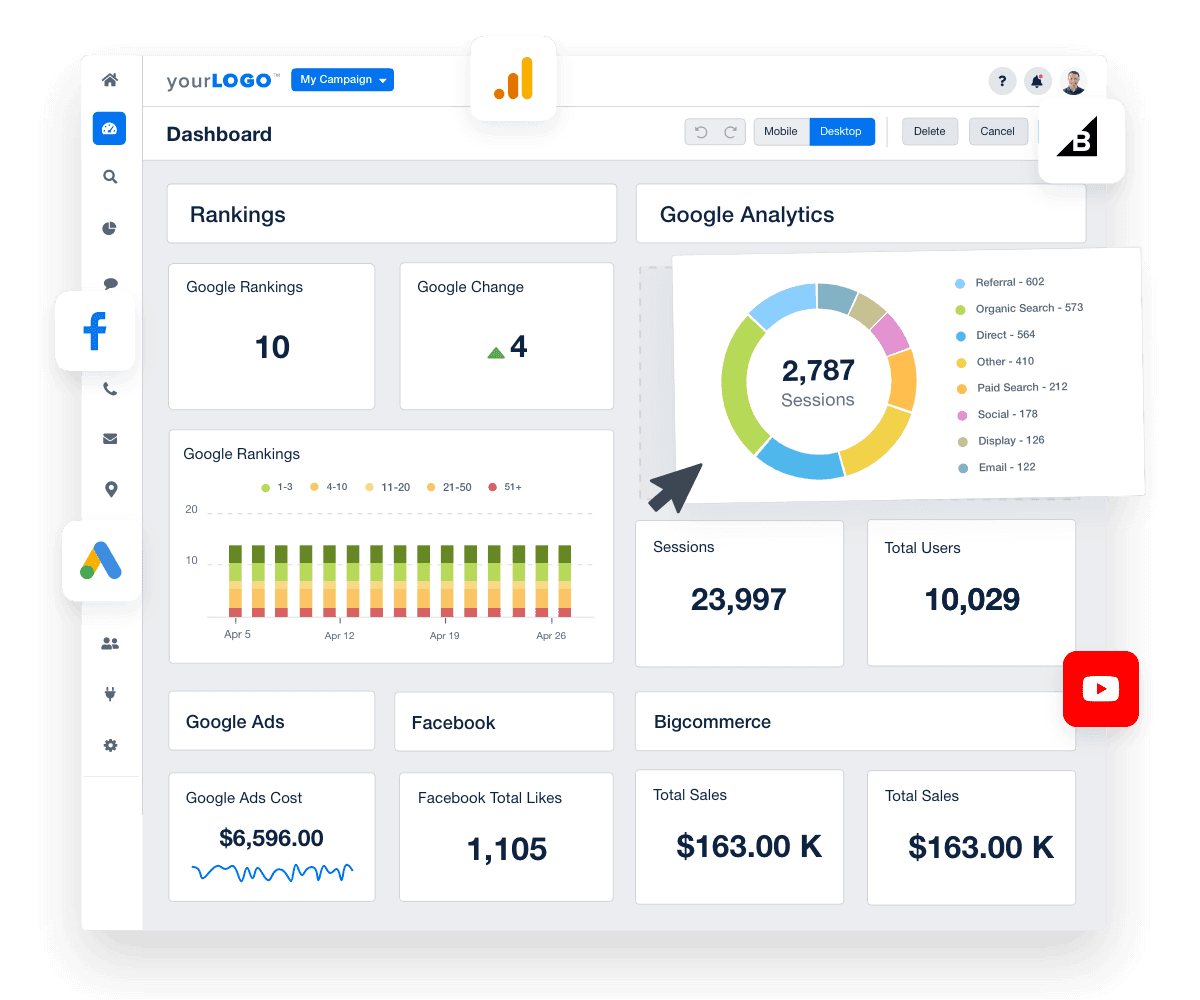
This level of personalization ensures the reports you generate are tailored to the unique needs of your clients.
Choose Your Metrics and Visualization
AgencyAnalytics offers a wealth of options when it comes to metrics and data visualization. Whether you want to track total sales, monitor customer behavior, or analyze marketing channel performance, simply select the metrics that matter most to your agency or your client.
And the customization doesn't stop there. Choose how these metrics are visualized, using bar graphs, eCommerce goal widgets, pie charts, and trend lines–select the most effective visual representation for your client’s data. The goal is to present the information in the clearest and most impactful way.
Automate the Reporting Process
One of the standout features of AgencyAnalytics is its ability to automate the reporting process. Once you've set up your dashboard and selected your metrics, schedule automated reports to save time and ensure consistent reporting.
Create client reports that are sent automatically to provide full transparency to your eCommerce clients. Start your AgencyAnalytics free trial today!
Leverage the Client Portal
AgencyAnalytics goes beyond just creating reports. The client portal feature allows clients and agency team members to log in and view live dashboards at any time. This ensures everyone is in the loop regarding overall eCommerce performance.
In the fast-paced world of eCommerce, creating insightful BigCommerce analytics reports quickly is key. AgencyAnalytics offers a practical solution combining customization, automation, and client engagement. With this platform, generating in-depth reports in minutes isn't just a possibility–it's a reality.
Summary and Key Takeaways
This article has taken a deep dive into BigCommerce analytics, examining its critical role in eCommerce marketing, the different types of data to track, the importance of client reports, and the power of using a platform like AgencyAnalytics for streamlined reporting.
The Power of Data: BigCommerce analytics and Google Analytics are both crucial in eCommerce marketing, providing insights into traffic, sales, and customer behavior. The data gleaned from these analytics tools helps inform marketing strategies, optimize campaigns, and ultimately drive eCommerce success.
Track the Right Metrics: There are various metrics to track in BigCommerce analytics, with each providing unique insights. Whether it's traffic, conversion, sales, or customer metrics, understanding the significance of each metric type is key to meaningful analysis.
Client Reporting Matters: BigCommerce analytics reports aren't just about data. They play a vital role in client transparency and help increase client retention, highlighting the performance of marketing campaigns and shaping future marketing decisions.
Streamlining Reports with AgencyAnalytics: AgencyAnalytics simplifies the reporting process, offering a customizable BigCommerce dashboard for easy report generation. Integrating data from BigCommerce and other marketing platforms presents a holistic view of your client’s eCommerce marketing performance.
The world of BigCommerce reporting may seem complex. However, it remains a powerful tool in the eCommerce marketing arsenal. Remember, reports aren't just about numbers. They're stories that tell the tale of an eCommerce journey; stories that guide your agency’s–and your client’s–future adventures in digital marketing.

Written by
Paul Stainton is a digital marketing leader with extensive experience creating brand value through digital transformation, eCommerce strategies, brand strategy, and go-to-market execution.
Read more posts by Paul StaintonSee how 7,000+ marketing agencies help clients win
Free 14-day trial. No credit card required.






